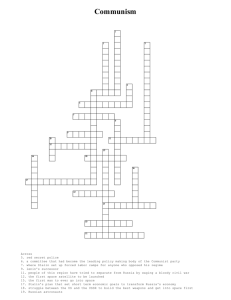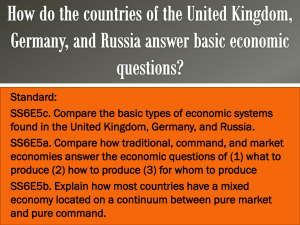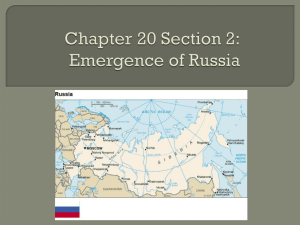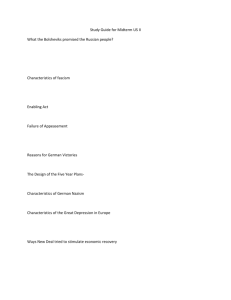1914
advertisement
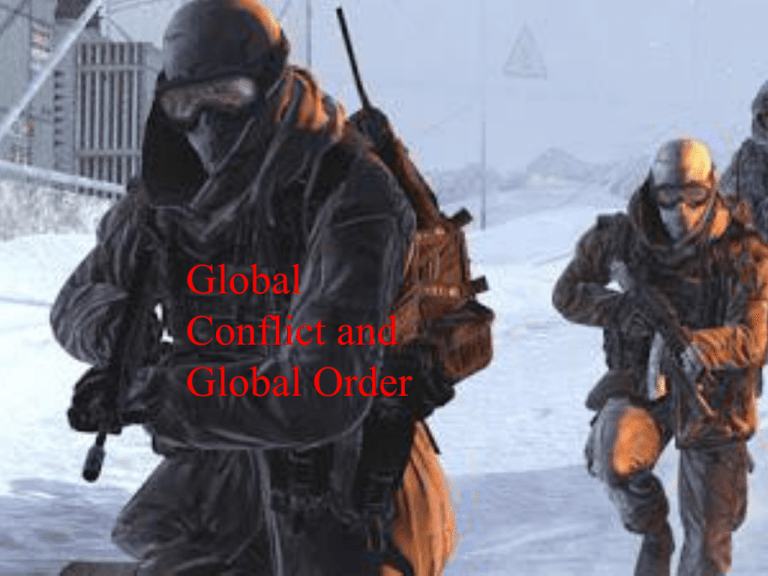
Global Conflict and Global Order I love war: http://www.youtube.com/watch?feature= player_embedded&v=KUB9QGKCNmI#! Armed conflict vs. order in international relations Armed conflicts arise from various causes International orders are created to prevent, resolve, or contain conflicts Rule-bound competition between interests? Controlled conflicts? Main models of international order: Hegemonic order Balance of power Democratic peace Network-based multipolar order “Six clusters of threats” to peace and security in contemporary world* 1. Socioeconomic threats, including poverty infectious disease environmental degradation 2. Inter-state conflict 3. Internal conflict, including Civil war Genocide Other large-scale atrocities -----------------------*UN Secretary General’s report “In Larger Freedom”: Report - Table of Contents ; UN Secretary-General’s High-level Panel’s report “A More Secure World: Our Shared Responsibility” : Report of the Secretary-General's High-level Panel 4. Proliferation and possible use of weapons of mass destruction nuclear radiological chemical biological 5. Terrorism 6. Transnational organized crime In contemporary world, it is often hard to draw a line between international conflicts and internal conflicts within nations – there is a tendency toward globalization of conflict Example: 4 levels of conflict in Afghanistan: 4 levels of conflict (Afghanistan as example): Internal conflicts are more likely to have international implications International developments tend to have more rapid and significant impact on internal situations Global – US and NATO vs. Al Qaeda and Taliban Regional – interests of neighbouring states National – Taliban vs. the Afghan Government, Pakistani Taliban vs. the Pakistani Government Local – opium industry, arms trade, ethnic conflicts All 4 levels are closely interconnected The tendency toward globalization of conflict has been developing since the start of World War I in 1914 What made world wars possible: 19th century economic globalization led to growing interconnectedness, integration of societies Struggle for power within countries acquired international dimensions Availability of economic resources Development of military technologies The culture of war New rationalizations of war The idea of total war National War Memorial, Ottawa World War I: 1914-1918 World War II: 1939-1945 The Cold War: 1946-1991 The Global War on Terror: 2001-? World War I: 1914-1918 was a cumulative effect of: -Rivalries between states (Germany-Britain, FranceGermany, Russia-Austria, Germany-Russia, RussiaTurkey, etc.) -Class conflicts within states -Nationalist struggles against empires The war for power and influence within the global system Expected to be brief The reality: a bloody 4-year stalemate Ended by revolutions in Russia (1917) and Germany (1918) 15 mln. deaths, incl. 9 mln. combat The flu pandemic of 1918-1919: 20-40 mln. deaths: a direct environmental effect of “the Great War” EUROPE, 1914 Declaration of war: Berlin Adolf Hitler celebrating the start of the Great War: Munich, Germany, Aug. 1914 Declaration of war: London Australian poster urging to volunteer German troops advancing on Paris French troops marching through Paris to the front Lethal gases: first weapon of mass destruction Endless slaughter British soldiers blinded by poisonous gas http://www.youtube.com/watch?v= zJZttzblHFQ&feature=related World War I in retrospective – the start of a century of global conflict Read Eric Hobsbawm’s article “The Future of War and Peace” Eric Hobsbawm: The Future of War and Peace A good reference library on World War I: Trenches on the Web - Reference Library See also this BBC site: BBC - History - The Western Front, 1914 - 1918 Animation THE WAR AS A REVOLUTIONARY FORCE Results of the war: -Collapse of 4 empires: Russian, Austro-Hungarian, German, Turkish -World capitalism severely undermined – North and South (economically, politically, socially, ideologically) -The rise of social protest and revolutionary movements everywhere The Russian Revolution, 1917 The 1917 revolution in Russia: The state has collapsed, citizen militias patrol streets Vladimir Lenin, leader of the Communist Revolution in Russia The radical proposal for a new world order The Peace Decree proclaimed by Russia’s new Soviet government in November 1917: 1. 2. 3. 4. 5. Call for immediate democratic peace without any territorial claims or indemnities Right of all nations to self-determination Willing to consider other terms proposed by other states Immediate armistice for 3 months Call to working people of the world to rise against “slavery and exploitation of any kind” Peace and revolution: were they compatible? Also: a promise to conduct diplomacy openly, without secret agreements with anyone Woodrow Wilson, US President in 1913-1920 The liberal-democratic proposal for a new world order: US President Wilson’s “14 points”, January 1918 Open diplomacy, no secret treaties Absolute freedom of the seas Free trade Maximum arms reduction Right of nations to self-determination Creation of an international organization to keep peace – League of Nations THE KEY THEME: “The principle of justice to all peoples and nationalities and the right to live on equal terms of liberty and safety with one another, whether they be strong or weak” At the end of World War I, Soviet Russia and the United States offered alternatives to the collapsed world order Despite similarities, the two alternatives were fundamentally incompatible: US strove to preserve global capitalism through reform Russia sought to help world revolution to destroy capitalism and replace it with communism Allies in World War I, Russia and America became enemies as a result of the Russian revolution US, Britain, France and Japan intervened in the Russian Civil War on the side of the counterrevolution They sent troops to occupy areas of Russia in the North and the Far East The US refused to recognize the Soviet Government until 1933 Leaders of Britain and France stuck to the old rules David Lloyd George, British PM George Clemenceau, French President At the 1919 Paris Peace Conference, Britain and France, most influential Western powers, were driven by traditional power considerations They insisted on severely punishing Germany They sought to create a balance of power in Europe which would not let Germany become strong again They also sought to isolate Soviet Russia They and other Europeans were sceptical of Wilson’s grand design for democratic peace The League of Nations, created at Paris, was rejected by the US Congress The world order created after World War I, was deeply flawed: it contained the seeds of the next world war Lloyd George, Clemenceau and Wilson at the Paris Peace Conference, 1919 World War II: 1939-1945 Sources: Rivalries between Great Powers continued, no stable world order The ideological conflict between world capitalism and world communism – a global civil war The rise of the Soviet Union ideologically committed to the destruction of capitalism The rise of the Left in Europe and Asia, fears of new revolutions The Great Depression, 1929-1933, shattered the global economy and exacerbated both international and class conflicts Rise of fascism as a force which destroys democracy to: defeat the Left reorganize states for global imperialist war Adolf Hitler Iosif Stalin Hitler publicly and repeatedly pledged to destroy the Soviet Union, billing himself as savior of the West from communism As a state committed to world revolution, Russia was viewed as a threat by Western elites The rise of fascism was partly a response to the threat – and anticommunism was one of the motives of Western appeasement of Hitler Stalin saw the prospect of a new world war as an opportunity for the spread of communism: the WWI precedent But ultimately, WWII was not about revolution: it was an interstate conflict of a traditional kind, similar to WWII, waged on a global scale The geopolitical triangle: Germany, USSR, Western democracies (WDs) WDs hoped to channel Hitler’s aggression to the East, toward conflict with Russia – reluctant to fight Germany Hitler was determined to prevent WDs and USSR from joining forces: beat them one by one Stalin was determined to avoid war with Germany as long as possible 1939: A divergence of interests between USSR and WDs – and a convergence of interests between Germany and USSR The unexpected deal was logical – but only temporary Moscow, August 23, 1939: German Foreign Minister Joachim von Ribbentrop signs non-aggression pact with Russia September 1, 1939: Nazi Germany invades Poland German troops in occupied Poland, 1939 Fascist dictators triumphant: Hitler and Mussolini in Munich, June 1940 Japanese attack on US Navy at Pearl Harbor, Dec.7, 1941 Nazi propaganda poster: SS forces kill the Red beast of communism Nazi soldiers celebrating success in “Lightning War” against Russia, 1942 Nazi reign of terror in occupied Russia Stubborn resistance Defenders of Moscow, October 1941 DIMENSIONS OF WORLD WAR TWO Ideological: Global Right (The Axis: Germany, Italy, Japan, Spain, and smaller allies) vs. Global Left (The USSR and the international communist movement) vs. Global Center (US, Britain, Nationalist China) 1939: Right and Left (Hitler and Stalin) make a deal, liberal democracy the big loser; the Right and Center at war 1941: The Right attacks both the Left and the US; a Center-Left coalition is formed 1945: The Right is defeated by the Center-Left coalition; the war’s aftermath gives a major boost to the global Left; liberal internationalism becomes the blueprint of a new world order Geopolitical The Axis was the challenger to the world order The West was torn apart by the war The Communist state, USSR, was in a position of a status-quo power and a victim of aggression – not as a revolutionary state The battle for Russia was decisive for the defeat of the Axis challenge Russia’s decisive role entitled it to geopolitical gains from common victory The turning point of WWII. February 1943: German troops surrender at Stalingrad, Russia Breaking the Nazi war machine June 1944: Allied forces land in Normandy to liberate German POWs, Russia, 1944 German POWs outside Moscow, 1944 The victorious Allies: British PM Churchill, US President Roosevelt and Soviet Generalissimo Stalin at Yalta Conference, Russia, Feb.1945 The Soviet Red Army takes Berlin, May 1945 Berlin, 1945: surrender of the German High Command Survivors of a Nazi concentration camp July 1945: Stalin, Truman and Churchill at Potsdam, Germany Aug.6, 1945: US atomic bombing of Hiroshima, Japan Total number of human lives lost in WWII – 60-80 mln. (est.) Total cost – Over $2 trln. (in 1990 US dollars)



